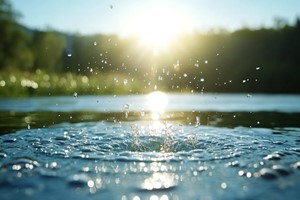Reuse of municipal wastewater is a proven and promising option for developing non-conventional water resources. In fact, it has been argued that the greatest potential for wastewater reuse is through using properly treated wastewater as a substitute for conventional ground and surface water sources.
The scarcity of water has motivated the Qatari government to introduce wastewater treatment and reuse as an additional water resource in their national water resource management plan. Representing a major investment by the Qatar Government, construction is in progress for the largest greenfield wastewater treatment, water reuse and sludge treatment plant in the Middle East: The Doha North Sewerage Treatment Works (Doha North STW).
This modern facility will feature advanced biological treatment processes, membranes for tertiary treatment and ultraviolet (UV) technology for disinfection to produce high quality reclaimed water for reuse. For the past three decades UV technology has been successfully used around the world for municipal applications including wastewater and drinking water disinfection.
UV is a cost-effective and reliable technology that protects the public against pathogenic microorganisms, including protozoa, bacteria and viruses. As a growing alternative and in many cases, a direct replacement technology to chemical (chlorine) disinfection, UV does not produce harmful by-products and is non-toxic.
The presence of pathogenic bacteria, viruses and protozoa in wastewater and drinking water represents a potential risk to the public. To prevent the transmission of waterborne diseases, regulations specify water treatment processes, nutrient removal, final effluent quality and disinfection criteria based upon the specific requirements of the reuse application.
UV disinfection systems have been successfully designed, tested and installed in thousands of municipal treatment plants around the world. While individual applications (e.g., wastewater, stormwater, drinking water) and treatment objectives differ, they have one important goal in common - to provide cost-effective and safe water for the public while minimizing the environmental impact of the treatment process.


UV disinfection of wastewater is a physical process whereby ultraviolet lamps, producing energy in the UVC range (200-400 nm), are housed within a specifically designed treatment reactor. The UV lamps produce photons that attack the microorganisms in wastewater as it flows through the reactor. Within a few seconds of exposure, the DNA of the microorganisms is permanently altered and the bacteria can no longer reproduce or infect those coming in contact with the water.
Doha North STW
With a peak design capacity to treat wastewater of up to 439,000 m3/day, Doha North STW will serve a projected population of over 900,000 people. With the facility becoming a source of water supply for non-potable use, it will free up precious drinking water supply for the community. Doha North STW selected the TrojanUV3000PlusT system (instead of chlorine) to disinfect their municipal wastewater plant effluent to reuse standards.
UV Disinfection System at Doha North STW
The UV system consists of seven duty UV channels for the current design capacity plus provision for expansion of one additional channel to meet the future peak flow. For the current capacity, 420 UV modules are installed in the duty channels with provision to increase by an additional 120 modules to meet the future flow capacity.


Keppel Seghers (Singapore), the environmental arm of Keppel Integrated Engineering, in partnership with the Public Works Authority of Qatar designed, built and are operating the plant for a period of 10 years. The Doha North STW is the first wastewater treatment facility in Qatar to use advanced membrane and ultraviolet light to treat and reclaim high quality wastewater for non-potable use.
The disinfection performance of the installed TrojanUV3000Plus system was validated by a third-party in accordance with protocols outlined in National Water Research Institute (NWRI) UV Guidelines (2003) for wastewater reuse.
There are two Power Distribution Centers (PDCs) per channel and each PDC powers 30 UV modules in a "bank." Each bank with 30 UV modules contains 8 UV lamps per module for a total of 240 lamps per bank (with 2 banks per channel for a total of 480 lamps per channel). With seven duty channels, the system at Doha contains a total of 420 UV modules.
The TrojanUV3000Plus, an open channel system with horizontal low pressure high output lamps, is the most-installed UV system of its kind in the world, giving the Public Works Authority of Qatar confidence in its performance and proven experience.
Because UV is a nearly instantaneous physical process where the effluent requires a contact time of only seconds, the required treatment footprint is a fraction of that of chemical disinfection methods - where contact times can be in excess of 30 minutes (>90 or 120 minutes for reuse) and large concrete holding tanks are required.














